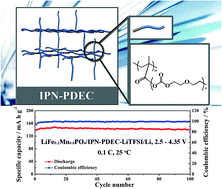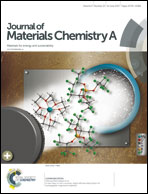An interpenetrating network poly(diethylene glycol carbonate)-based polymer electrolyte for solid state lithium batteries†
Abstract
Polycarbonate-based polymer electrolytes possess superior ionic conductivity at room temperature, higher lithium ion transference number and wider electrochemical stability window when compared with conventional poly(ethylene oxide)-based polymer electrolytes. Herein, the poly(diethylene glycol carbonate) dimethacrylate macromonomer (PDEC-DMA) was synthesized and the resultant interpenetrating network IPN-PDEC polymer electrolyte was developed via free radical in situ polymerization for polymer electrolyte Li metal batteries. This IPN-PDEC polymer electrolyte exhibited a decent ionic conductivity of 1.64 × 10−4 S cm−1 at room temperature and a wide electrochemical stability window (up to 4.5 V vs. Li+/Li). The LiFePO4/IPN-PDEC/Li and LiFe0.2Mn0.8PO4/IPN-PDEC/Li cells delivered excellent rate capability and cycling performance at room temperature. An all solid state lithium battery was also demonstrated by applying the as-prepared solid polymer electrolyte (SPE-PDEC) at a temperature of 100 °C, which displayed a superior cycling performance. Therefore, the IPN-PDEC network is a promising polymer electrolyte for solid state lithium batteries.



 Please wait while we load your content...
Please wait while we load your content...